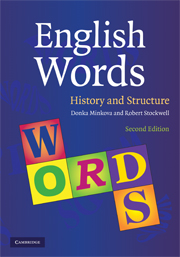Book contents
- Frontmatter
- Contents
- Preface to the second edition and acknowledgements
- An introduction to the textbook
- 1 Word-origins
- 2 The background of English
- 3 Composition of the Early Modern and Modern English Vocabulary
- 4 Smaller than words: morphemes and types of morphemes
- 5 Allomorphy, phonetics, and affixation
- 6 Replacement rules
- 7 Deletion rules and other kinds of allomorphy
- 8 Fossilized allomorphy: false cognates and other etymological pitfalls
- 9 Semantic relations and semantic change
- 10 The pronunciation of classical words in English
- Appendix: morpheme list
- Index
- References
1 - Word-origins
Published online by Cambridge University Press: 05 June 2012
- Frontmatter
- Contents
- Preface to the second edition and acknowledgements
- An introduction to the textbook
- 1 Word-origins
- 2 The background of English
- 3 Composition of the Early Modern and Modern English Vocabulary
- 4 Smaller than words: morphemes and types of morphemes
- 5 Allomorphy, phonetics, and affixation
- 6 Replacement rules
- 7 Deletion rules and other kinds of allomorphy
- 8 Fossilized allomorphy: false cognates and other etymological pitfalls
- 9 Semantic relations and semantic change
- 10 The pronunciation of classical words in English
- Appendix: morpheme list
- Index
- References
Summary
The two general themes of this book are the origins and the structure of English words. Our word-stock is huge. It is useful to divide it up between words that belong to the common language that everybody knows from an early age and words that are learned in the course of our education. The former, the core vocabulary, is nearly the same for everyone. The latter, the learned vocabulary, is peripheral and certainly not shared by everyone. The core vocabulary is not an area where we need special instruction – the core vocabulary is acquired at a pre-educational stage. Our learned vocabulary is a different matter. It varies greatly in size and composition from one individual to another, depending on education and fields of specialization. No single individual ever controls more than a fraction of the learned vocabulary. Often the extent of one's vocabulary becomes a measure of intellect. Knowledge about the history and structure of our words – both the core and the learned vocabulary – is a valuable asset.
The vocabulary of English is not an unchanging list of words. New words enter the language every day, words acquire or lose meanings, and words cease to be used. The online Oxford English Dictionary (OED) is updated quarterly with at least 1,000 new and revised entries; this is a fair measure of how dynamic our vocabulary is. The two sources of new words are borrowing and word-creation.
- Type
- Chapter
- Information
- English WordsHistory and Structure, pp. 5 - 23Publisher: Cambridge University PressPrint publication year: 2009

